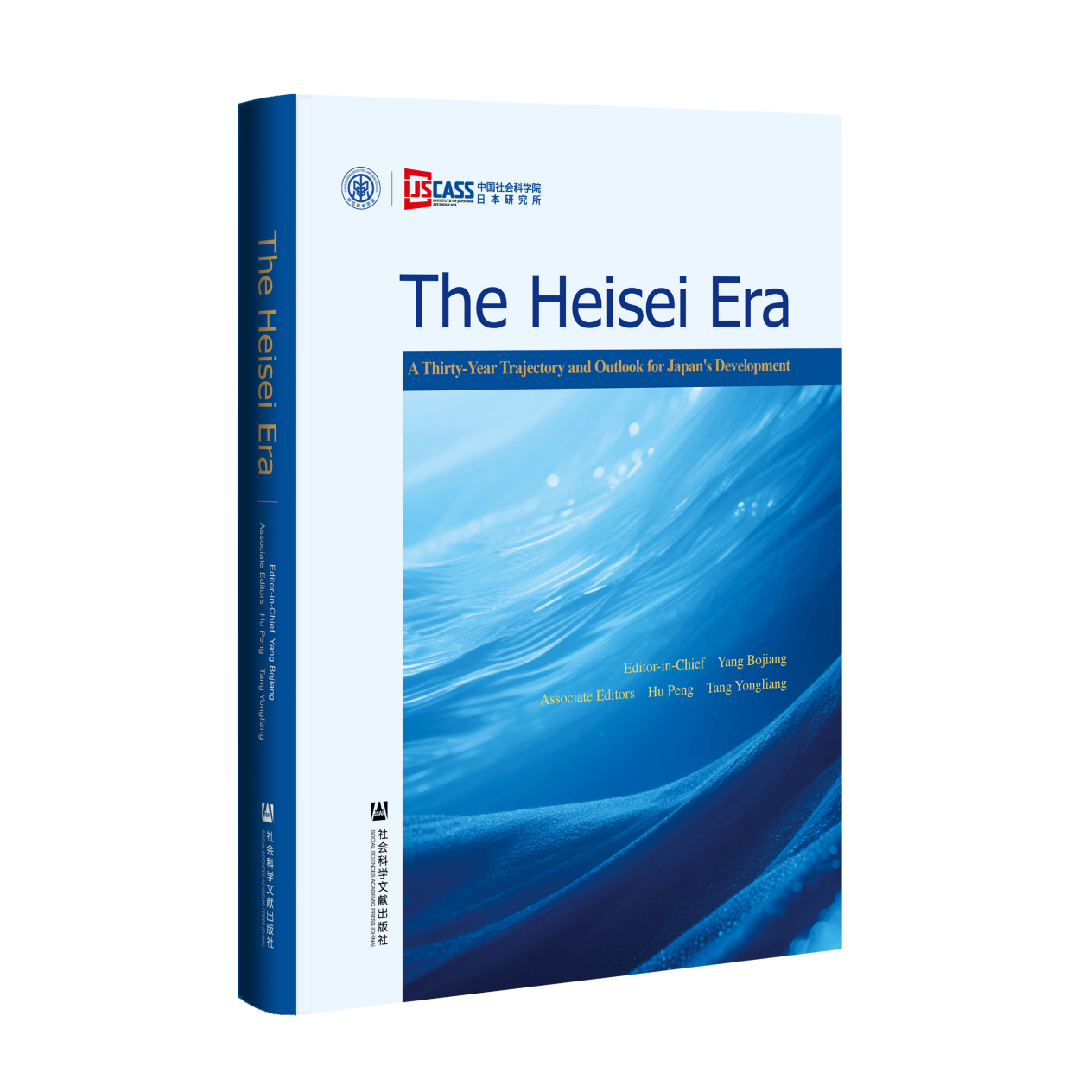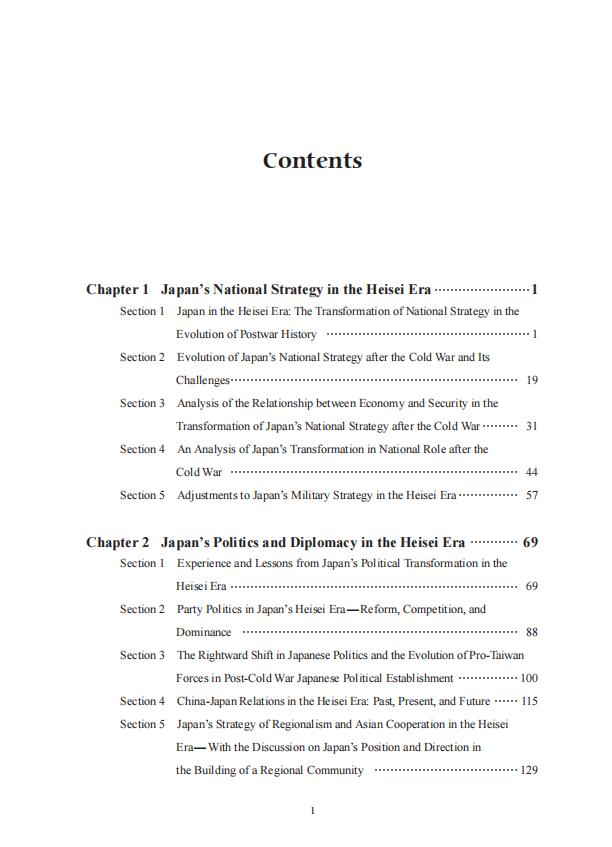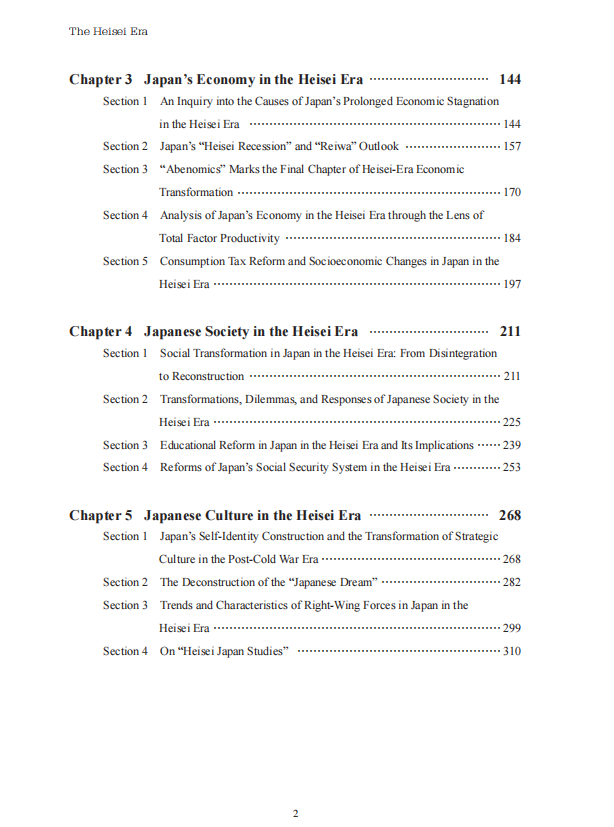The Heisei Era: A Thirty-Year Trajectory and Outlook for Japan’s Development
一、新书展示:  The Heisei Era: A Thirty-Year Trajectory and Outlook for Japan’s Development
The Heisei Era: A Thirty-Year Trajectory and Outlook for Japan’s Development
主编:杨伯江
副主编:胡澎、唐永亮
出版发行:社会科学文献出版社
出版时间:2025年8月
ISBN:978-7-5228-5837-1
二、内容提要:
《平成时代:日本30年发展轨迹与前瞻》英文版系在中文版基础上精心凝练并翻译出版之作。《平成时代:日本三十年发展轨迹与前瞻》中文版是国家社科基金首批社科学术社团资助项目成果,汇聚20多位活跃于日本研究前沿的优秀学者,聚焦1989-2019年日本平成时代,采用历史纵向与学科横向相互交织的分析框架,将平成30年作为一个独立阶段展开全学科研究。本书以“复眼”视角,从国家战略、政治外交、经济、社会、文化思潮五大关键领域进行深度剖析,构建起一个立体化的研究体系,力求为读者呈现出一个全面、真实的日本。2022年该书入选中国社会科学院创新工程重大成果。
本书兼具学术深度与现实关怀,是理解当代日本、展望中日关系的重要参照,对于研判日本未来走向具有重要参考价值,可为相关决策提供坚实的理论支撑。长期以来,国际学界的日本研究以欧美为主导,本书的出版不仅向国际学界展示了中国日本研究的最高水平,也是中国学术成果“走出去”的生动实践。
本书认为,平成30年是日本战后发展进程中至关重要的转型阶段。
国家战略层面,日本经历了从“经济中心”向“政治大国化”目标导向的转变,该目标的内涵趋于完整,实现目标的战略与政策体系日益完备。其内在逻辑,在于日本自身条件与剧烈变化的外部环境之间的相互作用,根本动力源于日本对重新成为“大国”的不懈追求。
经济层面,20世纪90年代初泡沫经济崩溃后,日本经济步入下行通道,且这种态势贯穿整个平成时代。由于经济低迷,加之人口老龄化等原因,日本政府不断扩大财政支出。经济长期低迷不仅削弱了日本的国际地位,也对日本社会、政治产生了深远影响。
政治层面,平成时代日本政党政治始于自民党“一党支配”格局的动摇,其间历经“多党重组”“两党竞争”,最终回归到自民党“一党独大”格局。“改革”“竞争”与“独大”构成了平成时代日本政党政治的核心内涵。
社会层面,“新自由主义”改革对日本经济、社会造成冲击,日本社会贫富差距拉大,从“一亿总中流”的相对均质状态走向贫富分化的“格差社会”。少子老龄化问题愈发严峻,家庭规模不断缩小,结婚率持续下降,晚婚不婚成为普遍趋势。
在社会与政治思潮层面,平成时代日本对于自身历史的认知发生深刻且重大转变。民族主义情绪抬头,意识形态整体呈现出明显的右移态势,网络右翼势力异常活跃。这一系列变化给日本政治、社会风貌以及对外姿态等诸多方面带来极为深远且复杂的影响。
本书创见性地提出了“平成日本学”这一新的学术研究领域,并诚挚呼吁学界针对该领域开展跨学科、跨领域的综合性研究,为深入理解日本提供更为全面、多元的视角。
Abstract
The Heisei Era: A Thirty-Year Trajectory and Outlook for Japan’s Development is a meticulously condensed and translated publication based on the original Chinese version, which is an outcome funded by the first batch of the National Social Science Fund's support program for academic societies. It brings together over 20 leading scholars active at the forefront of Japanese studies. Focusing on Japan's Heisei era (1989-2019), the book employs an analytical framework that interweaves historical longitudinal and disciplinary perspectives, treating the 30-year Heisei period as a distinct phase for comprehensive, multi-disciplinary research. Simultaneously, it adopts a "compound-eye" perspective to conduct in-depth analyses across five critical domains: national strategy, politics and diplomacy, economy, society, and cultural thoughts, constructing a multidimensional system aimed at presenting readers with a comprehensive and authentic picture of Japan. In 2022, the book was selected as a major achievement of the Innovation Project of Chinese Academy of Social Sciences (CASS).
This work combines academic depth with practical relevance, serving as a crucial reference for understanding contemporary Japan and envisioning China-Japan relations. It holds significant reference value for assessing Japan's future trajectory and can provide solid theoretical support for relevant policy-making. Long dominated by western perspectives in the international academic community, the publication of this book not only showcases the highest level of Chinese scholarship on Japan but also represents a vivid example of Chinese academic outcomes "going global".
The book argues that the 30-year Heisei period was a crucial transitional phase in Japan's post-war development.
At the level of national strategy, Japan underwent a shift from an economy-orientation towards the goal of becoming a "political great power”. The essence of goal became more complete and the strategic and policy systems for achieving it grew increasingly sophisticated. The underlying logic stemmed from the interaction between Japan's own conditions and the rapidly changing external environment, with the fundamental driving force originating from Japan's persistent pursuit of becoming a "great power" once again.
Economically, following the collapse of the bubble economy in the early 1990s, Japan's economy entered a downward trajectory, a trend that persisted throughout the Heisei era. Due to prolonged economic stagnation and reasons such as growing aging population, the Japanese government continuously expanded fiscal expenditures. This long-term economic downturn not only weakened Japan's international status but also had a profound impact on Japanese society and politics.
Politically, Japan’s party politics in Heisei era began with the shaking of the Liberal Democratic Party's (LDP) "one-party dominance" system. It went through phases of "multi-party realignment" and "two-party competition," eventually returning to an LDP "one-party dominance" structure. "Reform", "competition" and "dominance" constituted the core elements of Japan's party politics in Heisei era.
Socially, "neo-liberal" reforms impacted Japan's economy and society, widening the wealth gap and transforming Japan from the relatively homogeneous state of a "100 million middle class" into a "gap-widening society". Issues of low birthrate and aging population intensified, household sizes continued to shrink, marriage rates declined persistently, and late marriage and non-marriage became widespread trends.
In terms of social and political thoughts, Japan understanding of its own history underwent significant changes during the Heisei era. Nationalist sentiment rose, the overall ideological landscape showed a noticeable rightward shift, and the online right-wingers became exceptionally active. Those changes had extremely profound and complex influences on various aspects including Japanese politics, social landscape, and external posture.
This book innovatively proposes "Heisei Japan Studies" as a new academic field of study and earnestly calls for interdisciplinary and cross-field comprehensive research in this area to provide more holistic and diverse perspectives for a deeper understanding of Japan.
三、书籍目录:


